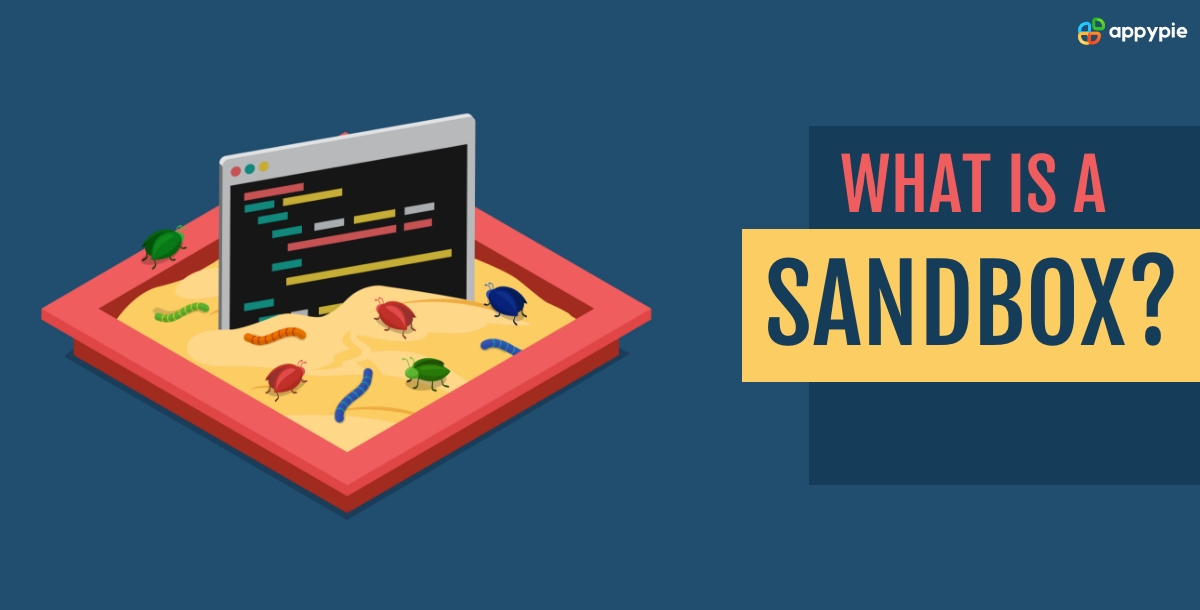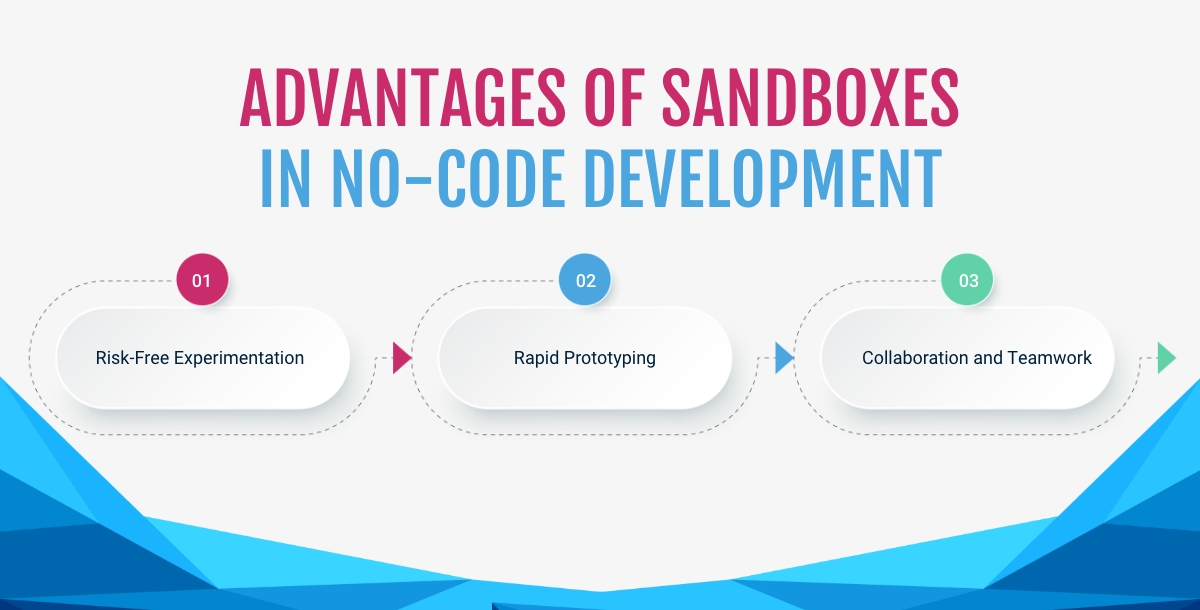The Benefits of Sandbox in No-Code Development

No-code development lets you build apps without writing code, but how do you test your application safely? That's where sandboxes come in! Sandbox provides a special environment where you can try out features, designs, and functionalities without affecting the final app. This blog will explain what a sandbox is and how it contributes to building successful apps using no-code platforms.
What is a Sandbox?

A sandbox is a special space that lets you try new things without affecting the production environment. It's like a practice area where you can test and play with different ideas safely. It provides a safe and isolated space for developers to try new ideas, make changes, and identify any potential issues before deploying their applications. This way, they can experiment, learn, and make changes without causing any harm or disruption. It's a great tool for learning and innovation.
Advantages of Sandboxes in No-Code Development

- Risk-Free Experimentation
- Rapid Prototyping
- Collaboration and Teamwork
One of the primary advantages of using a sandbox in no-code development is the ability to experiment without the fear of breaking anything. Sandboxes offer a safe and controlled environment where you can freely test different functionalities, workflows, and integrations. This allows you to fine-tune your application and identify any potential issues or bugs before releasing it to the public. By minimizing the risks associated with experimentation, sandboxes empower you to push the boundaries of your creativity and innovation.
Sandbox environments enable developers to quickly prototype and iterate on their ideas. With a no-code platform and a sandbox, you can easily drag and drop pre-built components, configure workflows, and customize the user interface without writing a single line of code. This accelerates the development process, allowing you to bring your ideas to life in a fraction of the time it would take using traditional coding methods. Rapid prototyping empowers you to gather feedback, make improvements, and iterate on your application, ensuring that it meets the needs and expectations of your target audience.
No-code development platforms that incorporate sandboxes foster collaboration and teamwork among developers, designers, and other stakeholders. Sandboxes provide a shared space where team members can work simultaneously, making changes, offering feedback, and collaborating on projects. This eliminates the need for lengthy code reviews, simplifies the communication process, and streamlines the development workflow. By promoting collaboration, sandboxes enhance productivity, efficiency, and the overall quality of the end product.
How Does a Sandbox Work?
A sandbox functions by creating a separate, isolated environment within the larger software development ecosystem. It operates independently from the production environment, ensuring that any changes or experiments made within the sandbox do not impact the live application. Sandboxes utilize virtualization or containerization technologies to achieve this isolation. They create a virtual machine or container that mimics the production environment, allowing developers to test their code in a realistic setting. This enables developers to identify and fix any issues or bugs before deploying the application to the live environment.
Key Features of Sandboxes
When choosing a no-code development platform with sandbox capabilities, there are several key features to consider.
- Version Control
- Testing and Debugging Tools
- Integration Capabilities
A robust sandbox should offer version control capabilities, allowing developers to track changes, revert to previous versions, and collaborate seamlessly. Version control ensures that you can always roll back to a stable state in case any issues arise during the development process.
Good sandbox environments should provide comprehensive testing and debugging tools. This includes features like automated testing, code analysis, and debugging functionalities. These tools assist developers in identifying and fixing any issues or bugs, ensuring the reliability and performance of the final application.
A sandbox should support seamless integration with other systems, APIs, and databases. This enables developers to create robust and interconnected applications without the need for complex coding. Look for a sandbox that offers a wide range of pre-built integrations and connectors to popular services and platforms.
How Can Appy Pie Help You in a No-Code Development?
Appy Pie is a leading no-code development platform that help you to creating and deploying applications without requiring coding expertise. Appy Pie's App Builder can significantly streamline this process. With its intuitive drag-and-drop interface, you can easily build, test, and launch an applications. You can also create a visually appealing website using Appy Pie's website builder. It also offers web hosting and domain name services.
Learn how to create an app with Appy Pie:
Step 1: Choose Your App’s Name
Begin by deciding on a name for your app that reflects its purpose. Then, sign up or log in to Appy Pie's app builder to initiate the app development process with your chosen app name.
Step 2: Customize Your App
Customize your app according to your specific requirements in just minutes. Integrate essential features in your app that enhance user experience and fulfill objectives without coding expertise.
Step 3: Test & Launch
This step involves the final step of launching your app. Begin by thoroughly testing its functionality and performance. Once you're confident in its readiness, proceed to officially launch your app, making it available for public access.
By following these steps and with the guidance of Appy Pie Experts, you can bring your idea to life. Appy Pie utilizes an internal sandbox environment. This built-in sandbox environment seamlessly connects with your no-code development process. This connection ensures a safe and smooth app development experience.
Conclusion
No-code development is revolutionizing the way applications are built, making it accessible to individuals without coding expertise. And at the heart of this revolution is the sandbox. Sandboxes provide a risk-free environment for experimentation, rapid prototyping, and collaboration. They enable developers to test their ideas, fine-tune their applications, and identify any potential issues before deployment. With powerful features like version control, testing and debugging tools, and integration capabilities, sandboxes enhance the development process and empower individuals to unlock the power of no-code development. So, whether you're a seasoned developer or a non-technical entrepreneur, embrace the sandbox and harness the advantages of no-code development to turn your ideas into reality.
Related Articles
- How to Remove Page Breaks in Google Docs with Pageless View
- ChatGPT: What Is It & How Can You Use It?
- ICE-G: Image Conditional Editing of 3D Gaussian Splats
- Customer Satisfaction Score: Insights, Importance and How To Measure
- How to use Google Forms and Google Spreadsheets to Update Inventory Automatically
- Ref-AVS: Refer and Segment Objects in Audio-Visual Scenes
- Top 11 Employee Experience Software Solutions Transforming Workplaces in 2024
- Can Feedback Enhance Semantic Grounding in Large Vision-Language Models?
- How to Choose a Blog Name [+ 100 Blog Name Ideas to Inspire You]
- Different Types of Infographics Design
